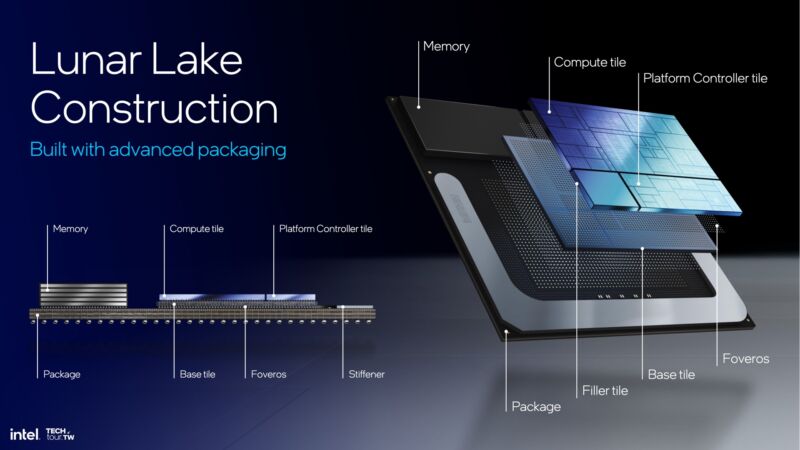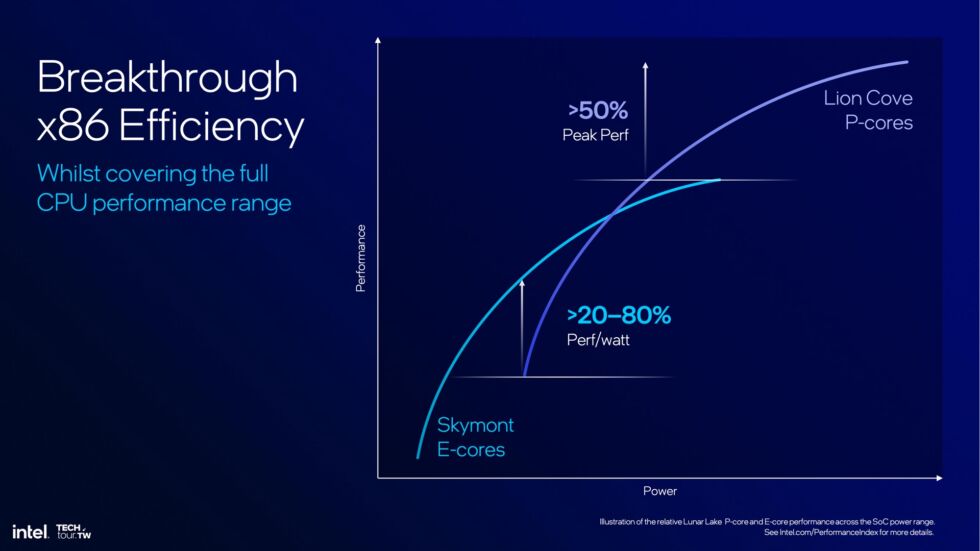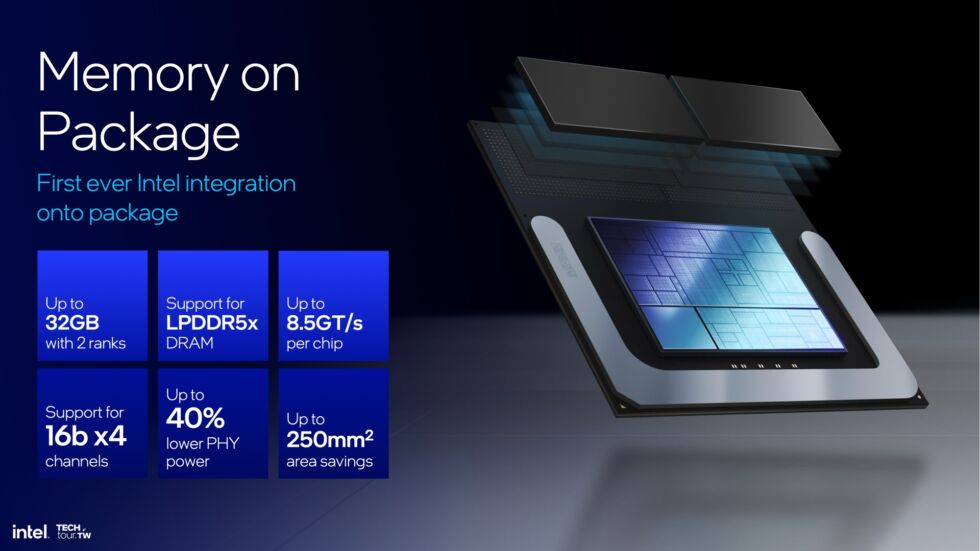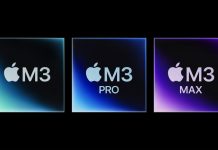Lunar Lake returns to a more conventional-looking design for Intel.

Given its recent manufacturing troubles, a resurgent AMD, an incursion from Qualcomm, and Apple’s shift from customer to competitor, it’s been a rough few years for Intel’s processors. Computer buyers have more viable options than they have in many years, and in many ways the company’s Meteor Lake architecture was more interesting as a technical achievement than it was as an upgrade for previous-generation Raptor Lake processors.
But even given all of that, Intel still provides the vast majority of PC CPUs—nearly four-fifths of all computer CPUs sold are Intel’s, according to recent analyst estimates from Canalys. The company still casts a long shadow, and what it does still helps set the pace for the rest of the industry.
Intel’s biggest laptop CPU update in years is a huge departure from past designs
Enter its next-generation CPU architecture, codenamed Lunar Lake. We’ve known about Lunar Lake for a while—Intel reminded everyone it was coming when Qualcomm upstaged it during Microsoft’s Copilot+ PC reveal—but this month at Computex the company is going into more detail ahead of availability sometime in Q3 of 2024.
Lunar Lake will be Intel’s first processor with a neural processing unit (NPU) that meets Microsoft’s Copilot+ PC requirements. But looking beyond the endless flow of AI news, it also includes upgraded architectures for its P-cores and E-cores, a next-generation GPU architecture, and some packaging changes that simultaneously build on and revert many of the dramatic changes Intel made for Meteor Lake.
Intel didn’t have more information to share on Arrow Lake, the architecture that will bring Meteor Lake’s big changes to socketed desktop motherboards for the first time. But Intel says that Arrow Lake is still on track for release in Q4 of 2024, and it could be announced at Intel’s annual Innovation event in late September.
Building on Meteor Lake

Lunar Lake shares a few things in common with Meteor Lake, including a chiplet-based design that combines multiple silicon dies into one big one with Intel’s Foveros packaging technology. But in some ways Lunar Lake is simpler and less weird than Meteor Lake, with fewer chiplets and a more conventional design.
Meteor Lake’s components were spread across four tiles: a compute tile that was mainly for the CPU cores, a TSMC-manufactured graphics tile for the GPU rendering hardware, an IO tile to handle things like PCI Express and Thunderbolt connectivity, and a grab-bag “SoC” tile with a couple of additional CPU cores, the media encoding and decoding engine, display connectivity, and the NPU.
Intel intros first Meteor Lake chips with faster GPUs and worse single-core speed
Lunar Lake only has two functional tiles, plus a small “filler tile” that seems to exist solely so that the Lunar Lake silicon die can be a perfect rectangle once it’s all packaged together. The compute tile combines all of the processor’s P-cores and E-cores, the GPU, the NPU, the display outputs, and the media encoding and decoding engine. And the platform controller tile handles wired and wireless connectivity, including PCIe and USB, Thunderbolt 4, and Wi-Fi 7 and Bluetooth 5.4.
This is essentially the same split that Intel has used for laptop chips for years and years: one chipset die and one die for the CPU, GPU, and everything else. It’s just that now, those two chips are part of the same silicon die, rather than separate dies on the same processor package. In retrospect it seems like some of Meteor Lake’s most noticeable design departures—the division of GPU-related functions among different tiles, the presence of additional CPU cores inside of the SoC tile—were things Intel had to do to work around the fact that another company was actually manufacturing most of the GPU. Given the opportunity, Intel has returned to a more recognizable assemblage of components.

Another big packaging change is that Intel is integrating RAM into the CPU package for Lunar Lake, rather than having it installed separately on the motherboard. Intel says this uses 40 percent less power, since it shortens the distance data needs to travel. It also saves motherboard space, which can either be used for other components, to make systems smaller, or to make more room for battery. Apple also uses on-package memory for its M-series chips.
Intel says that Lunar Lake chips can include up to 32GB of LPDDR5x memory. The downside is that this on-package memory precludes the usage of separate Compression-Attached Memory Modules, which combine many of the benefits of traditional upgradable DIMM modules and soldered-down laptop memory.
ARS VIDEO
What Happens to the Developers When AI Can Code? | Ars Frontiers
CPU, GPU, and NPU upgrades
- Intel’s next-gen NPU promises speeds of up to 48 TOPS, more than enough to hit Microsoft’s Copilot+ PC requirements. Intel
- One example of how a faster NPU helps in a real-world AI workload. Intel

Packaging technology is interesting to enthusiasts, but performance is what most people will talk about, which gets us to the new CPU, GPU, and NPU upgrades coming with Lunar Lake.
Intel rates the Lunar Lake NPU’s raw performance at 48 trillion operations per second (TOPS), a major increase from the Meteor Lake NPU’s 10 TOPS and enough to qualify Lunar Lake for Microsoft’s Copilot+ PC label. This will enable a number of features in Windows 11 24H2, including Recall and numerous image generation and enhancement technologies, that older Windows PCs won’t get.
Intel’s TOPS numbers here are a shade higher than Qualcomm’s 45 TOPS estimate for the Snapdragon X series and a shade lower than the 50 TOPS that AMD claims for the Ryzen AI 300 series, but all three are in the same general area in terms of raw performance. Intel says that Lunar Lake’s NPU can run through 20 iterations in the Stable Diffusion 1.5 image generator in 5.8 seconds, a task that takes 20.9 seconds on Meteor Lake’s NPU.
- Lunar Lake’s integrated GPU will be the first to use Intel’s next-gen “Battlemage” architecture, which will come to dedicated GPUs later. Intel
- The media and display engines also feature some mild generational upgrades. Intel

After the NPU, the most dramatic Lunar Lake improvement is to the integrated GPU. Intel says it’s actually its first GPU based on the next-generation “Battlemage” architecture, which will also eventually make it to market in the form of Arc B-series dedicated graphics cards (Intel is also calling it “Xe2”). The new GPU is up to 1.5 times as fast as the Arc GPU in Meteor Lake chips, which was already a significant upgrade over the Intel Iris Xe GPU that Intel shipped in 11th, 12th, and 13th-generation Core CPUs for laptops.Advertisement
Other graphics-related upgrades include hardware decode acceleration for the VVC video codec, 8MB of side cache for the media engine that will reduce the amount of power used for encoding tasks, and eDisplayPort 1.5 support for internal laptop displays.
- A high-level overview of the improvements to Lunar Lake’s P-cores. Intel
- Clock-for-clock, Intel promises performance improvements of about 14 percent while using the same amount of power. Intel
- New E-core improvements. Intel
- Intel says these E-cores are faster than the LP E-cores in Meteor Lake, but compared to the regular E-cores performance should roughly break even. Intel
- The Skymont E-core’s performance gains look impressive next to the oddball low-power E-cores from Meteor Lake. Intel
- But when compared to full-fat E-cores from a 13th/14th-gen Raptor Lake CPU, they roughly break even, albeit with slightly lower power usage. Intel

CPU performance should also improve in some ways, though the comparison with Meteor Lake is complicated—a fully enabled Meteor Lake CPU comes with six P-cores, eight E-cores, and two low-power E-cores, while a fully enabled Lunar Lake CPU only has four P-cores and four E-cores. Intel’s announcements were all short on direct performance comparisons with current-gen Core Ultra processors.
Intel does say that Lunar Lake’s new P-cores, codenamed Lion Cove, offer about 14 percent better performance than Meteor Lake’s Redwood Cove P-cores at the same clock speeds, which ought to help it beat the last-gen Raptor Lake’s single-core performance after Meteor Lake actually regressed a little.
The big thing missing from the new P-cores is Hyperthreading, which Intel has used to make more efficient use of individual processor cores on and off since the Pentium 4 days in the early 2000s. Intel’s E-cores have never included Hyperthreading, but P-cores have used it up until now.
Intel says that in a modern CPU architecture with a mix of P-cores and E-cores, it made more sense to remove Hyperthreading from the P-cores and optimize the cores for single-threaded performance. After removing the parts of the design necessary to support Hyperthreading, Intel says it could hit the same single-threaded performance levels while using less die space and less power, while only minimally affecting general performance since the OS scheduler sends threads to the P-cores and the E-cores before taking advantage of Hyperthreading.Advertisement
As for the new E-cores, codenamed Skymont, it looks like they’ll use less power than Meteor Lake’s E-cores, but their performance will be a bit of a step sideways. Intel touts major performance improvements, but those slides are specifically comparing the Skymont E-cores against the pair of “LP E-cores” in Meteor Lake’s SoC tile, not the main cluster of up to eight regular E-cores in Meteor Lake’s compute tile. Some of Intel’s performance figures also compare Meteor Lake’s two LP E-cores to Lunar Lake’s four E-cores, where the quad-core part is clearly going to come out ahead.
When compared to Raptor Lake E-cores, Intel says that Skymont breaks roughly even at the same clock speeds. Skymont can offer approximately 1.2 times as much performance as Raptor Lake’s E-cores at the same power level.
Like Meteor Lake, the new Lunar Lake chips look like they’ll come with worthwhile GPU and NPU upgrades, but CPU performance could be a more mixed bag, given lower core counts. It could be that there’s a beefed-up version of Lunar Lake in the pipeline somewhere with a P-core and E-core count closer to Meteor Lake’s or that Intel has decided to scale Lunar Lake’s CPU back a bit so that it can focus on improving performance elsewhere. We’ll know more about the exact trade-offs when Intel announces its first Core CPUs based on Lunar Lake and once we have some real-world systems to test.
Listing image by Intel




